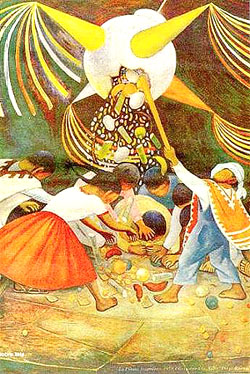|
Pinatas are fabulous creations, enjoyed the world over for their festive presence and promise of fun. These party decorations, made from brightly colored tissue and crepe paper, are popular attractions at children's birthday celebrations. In addition to their visual allure, the pinata's popularity is heightened by the candies and toys hidden inside.
Today, pinatas can be purchased that look like Sponge Bob, Superman or Hello Kitty. In the past, pinatas offered more traditional motifs, such as the 7-pointed star or the classic donkey. Most people associate pinatas as being definitively Mexican but their historical origins in part lay elsewhere. As you will see, the pinata's origins are multi-cultural.
 |
|
Diego Rivera , La Pinata | |
The great traveler and merchant Marco Polo is said to have encountered a version of the modern-day pinata when he was exploring the Orient 13th century. In the great country of China or Cathay as it was then known, Marco Polo observed the Mandarin people celebrating the New Year and other important holidays with animal effigies made of paper and ribbon. These miniature representations of farm animals were fashioned out of craft materials and constructed hollow to accommodate seeds. On the holiday in question, the effigy would be displayed, typically strung from a tree branch and beaten open with a stick, releasing the contents inside. Seeds were chosen for their symbolism, as they represented a good forthcoming harvest and also portended wealth and prosperity.
Legend claims that Marco Polo, upon his return to his native Venice, Italy, in addition to the exotic spices and luxurious silks he loaded onto his vessel he also brought an ancient version of the modern-day pinata. These early pinatas, once introduced to the Catholic Church, became intertwined with religious holidays, in particular for the occasion of Lent. It wasn't long before the tradition spread from Italy to Spain. In turn, when the Spanish came to the New World, they brought the pinata with them. The missionaries utilized the pinata to teach the natives their religious doctrine. Interestingly, the reason this method of teaching likely succeeded was that the indigenous peoples of Mexico already had in place their own version of the pinata.
The Aztecs reportedly would honor their God Huitzilopochtli each year with a gift for their deity. This offering took shape in the form of a clay pot that contained presents. Decorated with brightly colored feathers, this vessel would be cracked open with a stick at the height of the ceremony. Once the contents fell to the ground, this symbolized to the Aztecs that the offering had been received. Spanish missionaries weaved this local custom into their indoctrination. A pinata would be fashioned into a 7-pointed star for the explicit teachings of the seven deadly sins. After the missionaries lectured the indigenous peoples on this doctrine, the native people would be encouraged to symbolically overcome their sins by destroying the pinata.
The wearing of a blindfold while attempting to break open the pinata has its roots in the past as well. Ancient Mayans were known to play a favorite game blindfolded. Spanish missionaries, taking note of this practice, incorporated the blindfold into their teachings with the pinata. The Spanish missionaries likened the state of not being able to see with the importance of having faith.
Today, pinatas are more popular than ever. In Mexico, one can purchase pinatas at stores called 'pinateros' as well as at candy stores and grocery chains. Pinatas are also in demand in the United States and can typically be found at specialty shops and toy stores. For many, a child's birthday party wouldn't be complete without the pinata's presence. Children love the game of the pinata as well as the treasures hidden inside. Pinatas are frequently used as decorations at Cinco de Mayo celebrations and in Mexico, remain a steadfast tradition of 'Las Posadas'. This annual celebration beings on the ninth day prior to Christmas Eve and is a re-enactment of Mary and Joseph's quest in finding an inn for the night. Part of this celebration culminates with children being presented with the pinata.
|